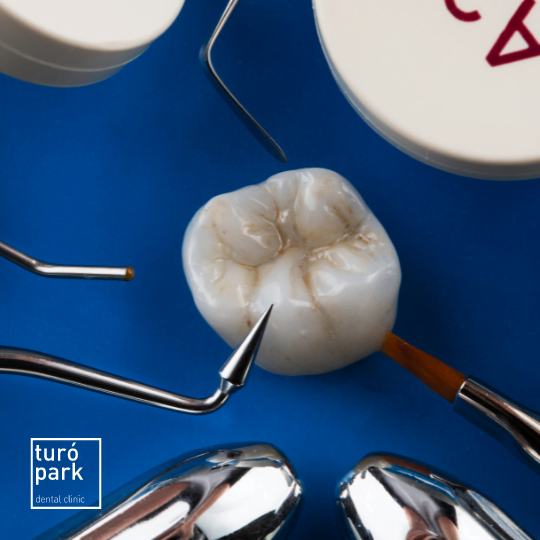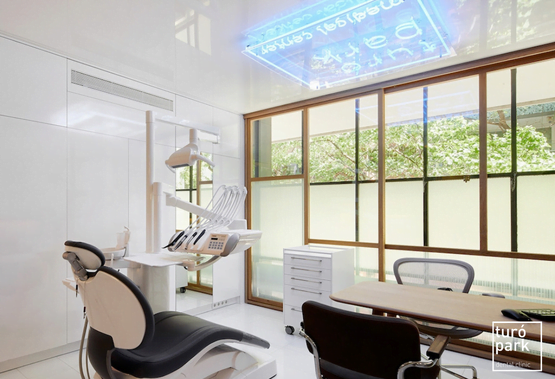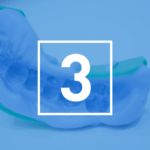Dental crowns in Barcelona : explore your options for restoring missing or damaged teeth
When one or more teeth are missing or very damaged, several solutions can be considered to replace them and regain the full functionality of a dental arch. Among these solutions, dental crowns are widely used because they offer a result that is both very natural and lasting.
If you are looking to replace one or more teeth in an esthetic and lasting way, do not hesitate to make an appointment with one of our English-speaking dentists specialized in dental esthetics in order to know which type of crown is the most adapted to your dental situation, and your budget!
At Turó Park Clinics, we offer metal-ceramic and full ceramic crowns on natural roots and implants.
What is a dental crown?
A dental crown is a fixed prosthesis which covers the whole or part of a tooth or implant. It is used to restore its shape and size, strength, and improve its appearance.
Fast track your treatment
To book an appointment or speak with one of our friendly team, please get in touch using the options below

Types of dental crowns and their advantages
There are a few different types of dental crowns available:
Porcelain-coated metal crowns have been and still are the most common restoration. The inside of the crown contains a small metal sleeve which is then covered with porcelain that gives it a pleasant external appearance. Their main advantages are their strength and the durability of the crowns on the tooth.
Porcelain crowns are probably the most common and widely used type of dental crown. They are extremely easy to obtain, have a good longevity and are not extremely expensive. They are also very natural looking and translucent. With all-ceramic crowns, in addition to avoiding dark margins, we manage to mimic the adjacent teeth very naturally.
The material you choose for your dental crown should be based on a number of factors such as your priorities and the role of the tooth. Depending on your personal needs and expectations in terms of budget, aesthetics, and durability, our dentists specializing in dental aesthetics can help you make the right choice for your dental crown in Spain.
Get your smile back!
Our specialised dentists offer you treatments adapted to your needs and your budget.

Indications for dental crowns
A dental crown may be needed in the following situations:
- To strengthen and protect a cracked or severely worn down tooth
- To improve the resistance of an endodontically treated tooth
- To improve the appearance of a tooth (discoloration, unusual shape, etc)
In addition, you may be a candidate for a crown if you’re missing a tooth, and the dentist needs to put in a dental bridge or a tooth implant.
When you visit your English-speaking dentist in Barcelona for restoration, your dentist will explain this dental service and all that it entails.
Benefits of dental crowns for your teeth
Dental crowns provide an adequate solution to a range of dental problems.
- Durability: Crowns last the longest of most dental restorations, with a life of fifteen years or more.
- Aesthetics: Crowns can be made to restore the original shape of your tooth. The color can also be matched to the color of the adjacent teeth, restoring or improving upon your original smile.
- Protection: A dental crown is possibly the best protection that your dentist can give to a threatened tooth.
- Accessible price : Dental crowns are cheaper than implants!
However, there are also some disadvantages of dental crowns, such as the need to file the tooth into the right shape before the crown can be fitted. This action is often irreversible.
Getting a dental crown: the procedure

Step 1: Anesthesia
Before starting the process of making a crown, your dentist will anaesthetize the tooth and the surrounding gum tissue.

Step 2: Reshaping
Once the area is numb, the process can begin. Firstly the dentist files the tooth or teeth to reshape them. Now the tooth will be much smaller to make room for the dental crown and cement. Lastly the tooth is filed on the top and sides. This process is not painful as it will be numb thanks to the local anaesthetic.

Step 3: Impression of the tooth
After reshaping the tooth, your dentist typically will use a paste or putty to make an impression of the tooth to receive the crown. For your safety, we only work with the best dental prosthetics laboratories in Barcelona!

Step 4: Placement of the crown
Once the crown is ready, your dentist will cement the crown to your tooth. After the procedure is over and the anesthesia has worn off, the patient may feel some sensitivity with the temporary crown or some soreness in the gums around the tooth. The pain is very minimal though and shouldn't last long.
Our English-speaking dentists














They talk about us
Our answers to the most frequently asked questions about dental crowns
What is the difference between an implant and a crown?
How long does a dental crown last?
How to clean dental crowns?
Dental societies and organisations










Have a look to the financing options
Don't worry, we take care of everything!